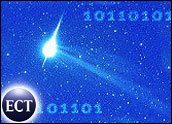
With funding from Microsoft cofounder and billionaire Paul Allen, the first nongovernment manned rocket ship is set to propel 62 miles from the Earth’s surface to reach space in a launch scheduled for June 21st.
SpaceShipOne, which soared two-thirds of the way to the 100-km, out-of-atmosphere point designated as space for the Ansari X Prize competition three weeks ago, will mark the first manned trip to suborbital space without government support. The scheduled flight, to take place in California’s Mojave Desert, will be open to the public.
“Since Yuri Gagarin and Al Shepard’s epic flights of 1961, all space missions have been flown only under large, expensive government efforts,” said the head of SpaceShipOne maker Scaled Composites and aviation veteran Burt Rutan. “By contrast, our program involves a few dedicated individuals who are focused entirely on making spaceflight affordable.”
The scheduled flight is another step in an incremental test program but is far more significant from a cultural or psychological standpoint, according to The Space Review editor Jeff Foust.
“If successful, this will be the first time that a privately developed vehicle carrying a human will go into space, albeit briefly,” Foust told TechNewsWorld. “It has the potential to really resonate with the public. They may see space as something far more accessible to them than ever before; that space is more than just NASA. It’s a big step toward the day where the biggest criterion for traveling into space will be the size of your checkbook.”
First Space Flight
Vulcan Ventures’ Allen, who has funded the SpaceShipOne project, called the scheduled space flight “one of the most exciting and challenging activities taking place in the fields of aviation and aerospace today.”
The privately developed rocket plane is set to be released from its companion craft, known as White Knight, and then climb to 50,000 feet over the Mojave Desert before it fires its rocket motor for about 80 seconds. SpaceShipOne will reach Mach 3 speed in its vertical climb to the goal height of 62 miles (100 km).
The pilot, who will become the first nongovernmental astronaut in history, then will fly the craft back to Earth after it reconfigures from rocket to glider plane. While SpaceShipOne is equipped with three seats for the X Prize requirement of three passengers or equivalent weight, the June 21st flight will be a solo trip.
Closing In on Challenges
However, Scaled Composites spokesperson Kaye LeFebvre told TechNewsWorld that if the next flight is successful, the company will add either two more passengers or the equivalent weight to move closer to the US$10 million X Prize, which requires a three-person trip to space that is repeated within two weeks.
Foust called the ability to fly to the same altitude with the full payload and the follow-up flight within two weeks the biggest challenges for SpaceShipOne. Still, he already has predicted that, barring problems, the craft could win the X Prize within the next couple of months.
LeFebvre said Scaled is not making any announcements or timeline estimates beyond the June 21st flight.
“It’ll depend on how this flight goes,” she said.
Beacon of Business Plan?
Crediting Rutan and the Scaled Composites team with accomplishing “amazing things” without government backing, Allen said SpaceShipOne proves that a privately funded space industry is possible.
“Every time SpaceShipOne flies we demonstrate that relatively modest amounts of private funding can significantly increase the boundaries of commercial space technology,” Allen said in a statement.
Foust said “modest” might be in the eye of the beholder, but Allen’s funding had shown that a relatively small amount of money — on the order of a few tens of millions — can fund development of a manned, reusable, suborbital spacecraft that could open new markets, such as space tourism.
“What will be more interesting to see is how committed he is to this or other commercial space ventures, particularly if they require additional larger investments,” Foust said. “Presumably, Allen has a business plan to convert SpaceShipOne or its successors into profitable space tourism or other ventures, but he has released few hints about what his future plans might be.”
Not the Only SpaceShipOne
Foust also highlighted the importance of other X Prize competitors, which include about two dozen teams at various stages of development, including id Software’s John Carmack and Armadillo Aerospace, The da Vinci Project and Canadian Arrow of Canada, and the United Kingdom’s Starchaser.
“The other competitors are important for two reasons: First, there’s no guarantee that Scaled Composites will win — technical or other unforeseen problems could delay their X Prize bid and allow an opening for a competitor; second, there will certainly be life after the X Prize is won,” Foust said.
Referring to plans for an annual competition called the X Prize Cup that would be held in New Mexico beginning next year, Foust added that many of the other teams likely will try to seek customers for space tourism and other ventures, which also could include remote sensing, microgravity testing or even package delivery and transportation.
“Even if SpaceShipOne wins the X Prize, several competitors could find long-term success commercially,” Foust said.





















































